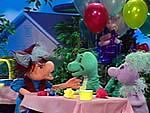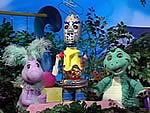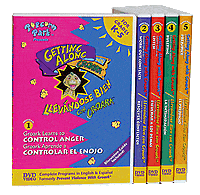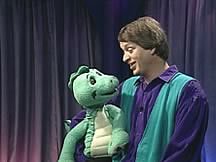This material is from the teaching guide
for the video “Groark Learns to WORK OUT CONFLICTS“
in the 10-part DVD series GETTING ALONG with GROARK
HOW TO WORK OUT CONFLICTS
(Fairly and Peacefully)
![]() 1. STOP . . .
1. STOP . . .
before you lose control of your temper and make the conflict worse.
![]() 2. SAY . . .
2. SAY . . .
what you feel is the problem. What is causing the disagreement? What do you want?
![]() 3. LISTEN . . .
3. LISTEN . . .
to the other person’s ideas and feelings.
![]() 4. THINK . . .
4. THINK . . .
of solutions that will satisfy both of you.
If you still can’t agree, ask someone else to help you work it out.
DISCUSSION QUESTIONS
If you are using the video, ask the first two questions before viewing.
1. Have you ever started working on a project with a friend and gotten into a disagreement? What caused the disagreement?
2. How did you feel? What did you say or do?
3. Why did Groark and Essie get so angry at each other?
 4. Did getting angry make things better or worse?
4. Did getting angry make things better or worse?
5. Were they listening to each other? What happens when people who disagree don’t listen to each other?
6. What could Groark and Essie have done to keep their disagreement from getting out of control?
This material is from the teaching guide
for the video “Groark Learns to WORK OUT CONFLICTS“
in the 10-part DVD series GETTING ALONG with GROARK
7. Who do you think was really to blame for the conflict? Why?
8. How did Essie feel? How did Groark feel?
 9. In the end, did they both get what they wanted? How were they able to do that?
9. In the end, did they both get what they wanted? How were they able to do that?
10. Why is it important to settle conflicts peacefully? What can happen if you don’t?
11. Are there some conflicts that can’t be resolved?
12. What did you learn from this video?
(If you wish to copy or use any material from this website, please click here for Terms of Use.)
 |
To find teaching guides on Resolving Conflicts and related topics for other grade levels |
 |
STUDENT ACTIVITIES
1. Write the steps for working out conflicts (see the top of this column) on the board. Discuss each step.
2. Ask the children to describe a variety of conflicts that commonly occur at school. List these on the board. Select two or three of these and discuss how the steps for working out conflicts could be applied to each situation. Have the kids role play some of these situations, either as themselves or with puppets. Afterward, have a group discussion to evaluate the outcome of each role play.

3. Introduce the concept of using words to express feelings instead of blaming someone else or using physical force.
Example: “It really bothers me that you aren’t willing to work this out together instead of arguing all the time.”
A “blaming” message says what’s wrong with the other person.
Example: “You are ruining our project. You’re a jerk. You never do anything right.”
A “why” message is constructive and points to a solution. A “blaming” message puts the other person on the defensive and leads to more conflict. “Why” messages usually work better.
Referring to the list of conflicts on the board, have students role play with puppets or as themselves using “why” messages instead of “blaming” messages.
(If you wish to copy or use any material from this website, please click here for Terms of Use.)
Other teaching guides in this series:
 |
• Controlling Anger • Working Out Conflicts • Being Good Listeners |
• Bullying & Teasing • Prejudice & Respect |
 |
This material is from the teaching guide
for the video “Groark Learns to WORK OUT CONFLICTS“
in the 10-part DVD series GETTING ALONG with GROARK
WRITING ASSIGNMENTS
1. Read a story aloud to the class. Have the kids identify the conflict. Students can then draw a picture showing how the conflict can be resolved or write their own ending.
 2. Write a group story with students contributing ideas for characters, conflict, and how to resolve the conflict. Have the class draw illustrations and create a book which can be kept in the classroom to be read by the students.
2. Write a group story with students contributing ideas for characters, conflict, and how to resolve the conflict. Have the class draw illustrations and create a book which can be kept in the classroom to be read by the students.
3. Have students identify several conflict situations that often occur between people their age. Divide a sheet of paper in half or create two lists on the board. On one side write “blaming” messages for the situation. On the other side write “why” messages that could be used instead.
4. (For older kids) Write a short story about a conflict. Make up two endings. In one ending the conflict is resolved peacefully and fairly, and in the other it isn’t.
(If you wish to copy or use any material from this website, please click here for Terms of Use.)
To enlist the involvement of parents, make copies of the “For Parents” block (see below) and send them home with the children. Tell the children to discuss the video with their parents, and to perform the following activities.
1. Take home Groark’s rules for “How to Work Out Conflicts” (at the top of this column) and post it in a place where family members can learn and practice the steps.
2. Ask family members or friends to describe conflicts they have experienced. Discuss how the steps for working out conflicts could have helped.
 3. Draw a picture showing Groark and Essie working out their conflict. Tell your family about the conflict and how it was worked out.
3. Draw a picture showing Groark and Essie working out their conflict. Tell your family about the conflict and how it was worked out.
4. When someone uses a “blaming” message in a conflict with you, ask that person to use a “why” message instead. Try not to use “blaming” messages yourself.
5. Watch how the characters in a TV show or movie handle their disagreements. Do they lose their temper or control their anger? Do they blame each other? Do they work out their differences fairly and peacefully, or do they fight it out? Could they do better by using the four steps for working out conflicts? Discuss these things with your family members.
Note to the teacher or group leader: It might be a good idea to think of some way for the children to share the outcomes of these activities with each other. Perhaps they could give written or oral reports or discuss their experiences in small groups.
(If you wish to copy or use any material from this website, please click here for Terms of Use.)
(Copy this block and send it home to the parents.)
FOR PARENTS
Dear Parent,
Your child is learning some valuable skills which will help him or her get along well with others, solve conflicts peacefully, and avoid violent situations.
The current lesson is about working out conflicts. We have shown your child a video entitled “Groark Learns to Work Out Conflicts”, which presents a puppet show and discussion about how to resolve conflicts without fighting.
Here are some things you can do to help your child learn to work out conflicts fairly and peacefully:
• Ask your child to tell you about the video program and what he or she learned from it.
• Ask your child to explain the four steps for working out conflicts that he or she has learned at school. Post them where everybody can refer to them and use them to resolve family disagreements.
• When conflicts arise with siblings or friends, call “time out” so they can cool off. Help them use the four steps to work out their conflict.
• Ask your child to explain the difference between “why” and “blaming” messages. Try to use “why” messages as often as possible and avoid “blaming” messages.
This material is from the teaching guide
for the video “Groark Learns to WORK OUT CONFLICTS“
in the 10-part DVD series GETTING ALONG with GROARK
WORK OUT CONFLICTS “
the video
This video teaches children:
• That conflicts between people are normal.
• How to prevent minor disagreements from escalating into serious fights.
• Steps for working out conflicts fairly and peacefully.
• Both English and Spanish on the same DVD.
• Closed Captioned for the Hearing Impaired.
“Getting Along With Groark “
with GROARK”
the series
For more information about individual videos in this series, click on a topic below.
• Controlling Anger
• Working Out Conflicts
• Being Good Listeners
• Bullying & Teasing
• Prejudice & Respect
If your school or organization does not have these videos, you can purchase them from Live Wire Media, or request them from your local library.
Subscribe to our almost
Monthly Newsletter
Get breaking news and developments in character education and helpful tips and ideas that you can use with your own character education program.
View the current issue.






